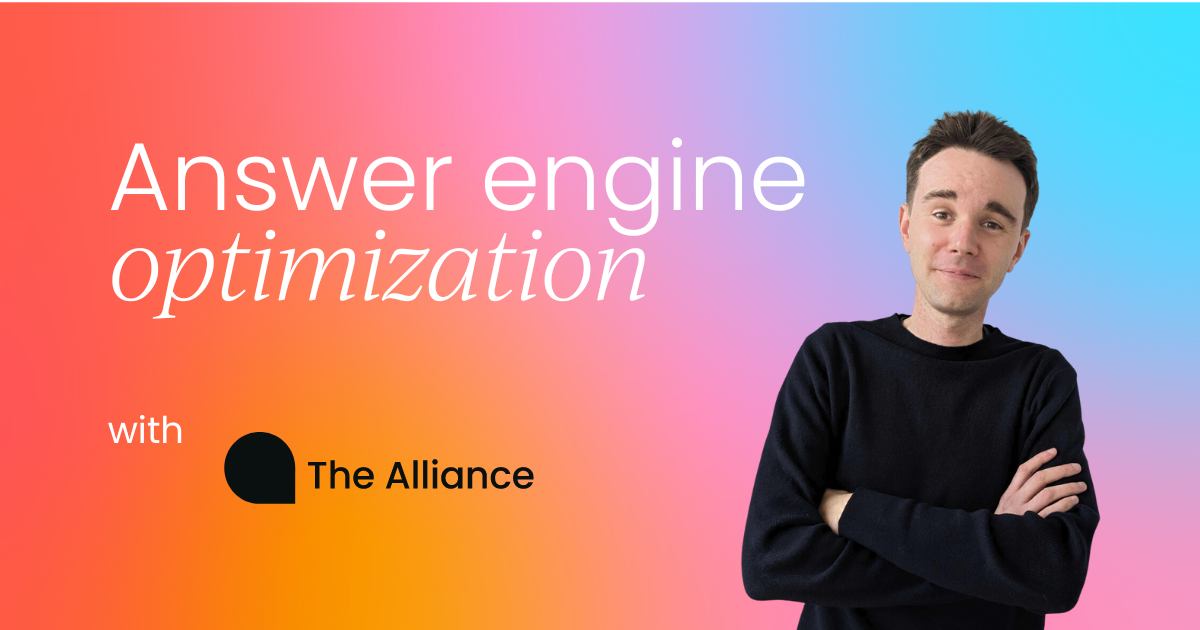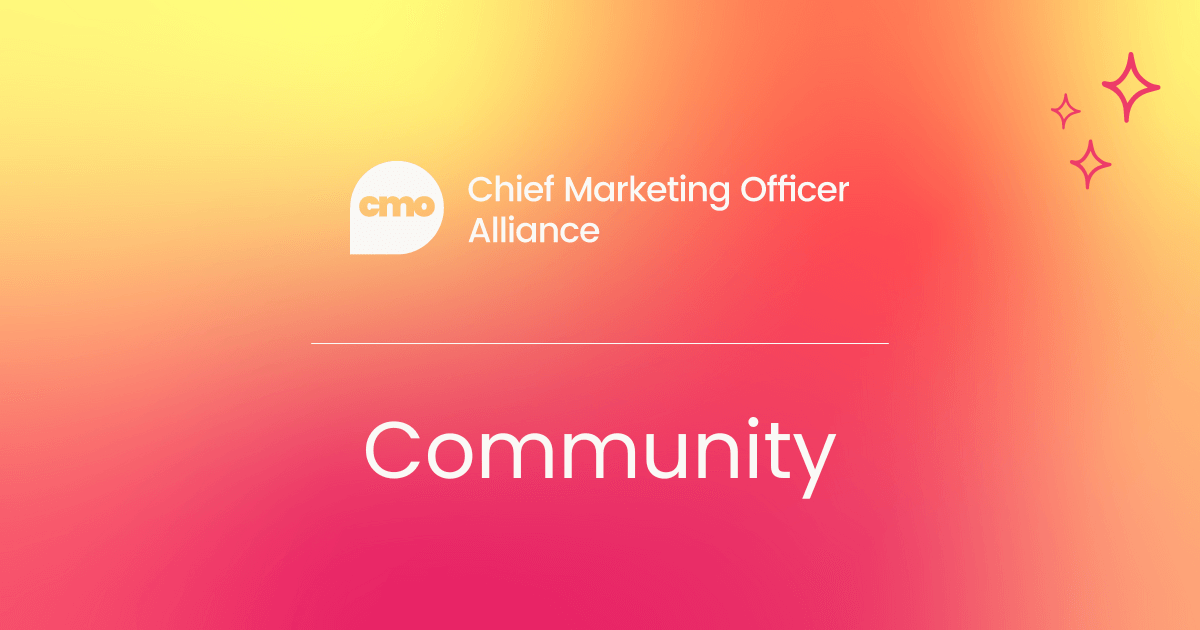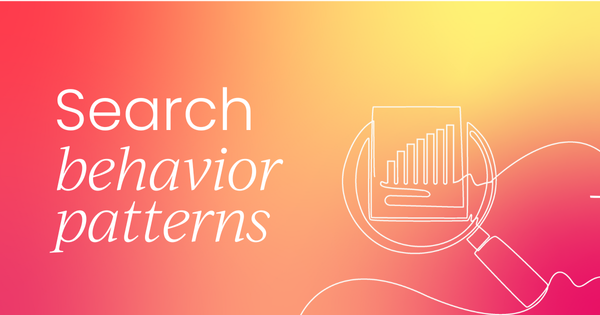The way people search for information is changing fast.
It might have started with search engines like Google but, now, users research through AI, social media, and voice assistance, and algorithms are personalizing results in real time.
But what’s influencing this change?
Search behavior marketing definition
With search behavior marketing, you can analyze and leverage people’s online search behaviors to optimize your marketing strategies.
You study how users search for information, the keywords they use, their intent (information, navigational, transactional), and their journey through search engines to tailor your ads, content, and user experience.
You can use these insights to improve your SEO, optimize PPC (pay-per-click) ads, personalize your content based on search intent, and ensure people have the best experience with your site.
Why is search behavior changing?
ChatGPT vs. Google
More people are turning to ChatGPT instead of Google – in fact, in 2023, about 13 million people “used generative AI as their primary tool for online search”. This number is expected to jump to 90 million in 2027.
People choose AI because they also get summarized answers to their queries instead of just links, meaning AI-generated responses are changing the way we consume and trust information.
AI Overview
And, because Google introduced their search generative experience, known as AI Overview, which appears before the usual organic results, people are not clicking through to websites as much.
You also get hyper-personalized search results based on past behavior, browsing history, etc., meaning you don’t often need to type full queries – this also changes the way we approach search.

Other platforms as search engines
Google still has the majority of the market share at 90.14%, followed by Bing at 3.95%, so most people still conduct their online searches on Google.
Source: StatCounter Global Stats - Search Engine Market Share
However, Google has lost some ground to Instagram and TikTok as Gen Zers are more likely to use social media as their search engine, more so than other generations.
Searches also happen on Reddit and YouTube, and, for many, product search starts on Amazon, not Google – 74% of Italian shoppers, 68% of Spanish shoppers, and 65% of German shoppers choose Amazon when looking for a product.
Amazon is also testing a new feature that’ll make the platform more similar to Google when it comes to search. The app will have a feature that “displays select products in its search results even if it doesn’t sell them in its store and links to the brand’s website so customers can purchase items there”).
Privacy concerns
Data breaches cost businesses US$4.88 million in 2024, so it’s fair to say that privacy and security are increasingly important – and not just for companies. In fact, 1.6 billion people worldwide used a VPN (virtual private network) in 2024 and the market is expected to reach US$76 billion by 2027.
In addition, search engines like DuckDuckGo are becoming increasingly popular, since they don’t tend to record search history or queries (and don't share them with advertisers).
All of this, plus the use of incognito mode, changes the way people search, since it alters how their data is stored, tracked, and interpreted by search engines (which impacts your marketing and SEO efforts).
Content regulations
Regulations like the EU’s Digital Markets Act make Google and other search engines remove or restrict certain types of content – so, they have to alter the way they display and rank content in search results.
This legislation came into effect to promote fair competition and reduce the dominance of tech giants.
AI spam
It goes without saying that the rise of AI-generated content has a big impact on SEO, especially when it comes to maintaining the quality and authenticity of search results.
Many AI-generated sites use AI to create large volumes of content to game the algorithms – in essence, AI spam manipulates search through things like keyword stuffing and link farming.
Google is taking measures to prevent this, as they launched a core update to reduce the visibility of this type of content in search results.
What other factors are influencing search behavior?
What else influences the way people search?
- Psychological factors: how much information people can process at once and the trustworthiness of the source. Also, the experience people have with a certain topic will usually affect their search queries too.
- Demographics: age and education matter, since different generations tend to search differently (e.g., the example of Gen Z using TikTok as a search engine).
- Devices: shorter queries tend to be on mobile and longer on desktop, which also changes the way we search.
- Search engine features: for example, Google’s autocomplete guides user behavior, and so do featured snippets and AI Overviews, since they influence what users click first.
- Context and environment: if people are in a rush, their search phrasing will be impacted. Mobile connectivity can also change how users search.
- Search literacy: some people craft precise queries while others opt for broad/vague terms.
- Content format: some users also prefer watching videos, while others prefer reading blogs or listening to podcasts.
Understanding search behavior models
When people use search engines, their behavior is anything but random – everything they click on, every search they do, all of it is shaped by psychology and cognitive biases.
Over the years, researchers have developed frameworks that explain how people search, why they refine their queries, and what drives them to click on certain results over others.
Here are some of the most popular models:
Information Search Process (ISP)
The ISP model was created by Kuhlthau in 1991 and described how people search in stages when solving a problem or making a decision. It applies to research-heavy searches, like buying a house or learning a new skill.
The stages are:
- Initiation: The user recognizes a need for information.
- Selection: They identify relevant sources or keywords.
- Exploration: They refine queries.
- Formulation: They gain clarity and focus on specific topics.
- Collection: They gather detailed information.
- Presentation: They use or share findings (such as their buying decision).
Long Tail Search Model
Chris Anderson, in 2004, suggested that while high-volume keywords drive traffic, long-tail keywords (low-volume, highly specific queries) drive conversions.
His theory means that marketing leaders should focus on long-tail keywords (“best AI tools for small businesses” instead of “AI tools”), create niche content to attract high-intent users, and optimize for voice search and natural language queries.

Search Intent Model
In 2002, Broder classified search behavior into three main types: navigational, informational, and transactional, which we’ll detail below.
Understanding these can help you to align your content with user intent – for example, you can create blog posts if you want to provide information for those seeking it, as well as product pages for people wanting to make a purchase.
Human search behavior patterns
Human search behavior patterns refer to how people look for information online and how they interact with search engines – a.k.a., we’ve looked at theoretical frameworks above, so let’s now look at the behaviors and actions people take in practice:
Navigational search
People search for a specific website or brand, which means it’s all about brand recognition and returning visitors. E.g., “CMO Alliance”.
Informational search
Users look for knowledge or answers to their questions, which typically leads them to blog posts, guides, etc. E.g., “What is consumer search behavior?”
Transactional search
This is when people intend to take action, which could be buying a product or signing up for something. E.g., “Sign up to our event”.
Comparative search
Users evaluate multiple options before deciding, meaning they rely on reviews, comparison tables, competitor analysis, and more. E.g., “Brand marketing vs content marketing”.
Question-based search
People use explicit questions with words like “how”, “why”, and “what”. This type of search is optimized for featured snippets and FAQ-style content. E.g., “Why is my email open rate so low?”.
Zero-click search
With features like AI Overview, you can get your answer directly from the search engine results without having to click on a link to a site – in the EU, 59.7% of Google searches end without any clicks. E.g., if you type “AI for marketing leaders” into Google, this is what you see:
Search pogo-sticking
Another search behavior pattern to consider is pogo-sticking, where users click on multiple results but bounce quickly to the search page if they don’t find what they’re looking for. This indicates they’re not satisfied with the content or with meta descriptions, so it represents a negative signal to search engines.
Query refinement
Sometimes, when people have an open-ended goal and are not exactly looking for a specific answer, they search for queries and progressively narrow them down. This requires content that guides them through the decision-making process from start to finish.
E.g., searching for “AI tools”, then “best AI writing tools”, then “ChatGPT vs. Gemini”.
F-pattern scanning
This is an eye tracking pattern that shows how people scan the content they read online – as well as the search results page.
The scan results in an “F” shape, since there’s a first horizontal movement (top of the content), followed by another that moves lower, and finally, a vertical scanning in which people scan down the left side, often skipping words.
This means you should design your content to reflect this shape:
- Your key points should appear in the first few lines.
- Use subheadings and bold text so people can quickly find relevant sections.
- Use bullet points and lists to improve scanability.
- Avoid large blocks of text and write short paragraphs instead.
Conversational queries
Long-tail, natural language queries are becoming increasingly popular, especially with AI and voice assistants that imitate real conversations. E.g., “What is the best tool for marketers?”
Multi-session and multi-device search
People don’t always complete their journey in one session or on the same device – they tend to research across multiple visits and switch between mobile, desktop, etc.
Social search
As seen, social media has had a huge impact on consumer search behaviors, with Gen Z setting the trend. You’re more likely to find queries like “best restaurants in NYC” on TikTok now – in addition, community-driven platforms like Reddit and Discord also influence the way we discover information.
And it’s important to remember dark search, meaning direct traffic from apps like Slack, email, and WhatsApp, where referral data isn’t captured.
Predicting user search intent
Tools like Semrush can give you an insight into the user intent of your keywords but, if you don’t use software like that, what signs should you be looking for?
Keyword analysis
Long-tail keywords tend to indicate more specific intent than short-tail ones (for instance, “best marketing automation software for startups” shows the intent is more investigational).
If users include “how” in their search, it’s often informational, whereas words like “buy” clearly indicate a transactional intent.
Analysis of the results page
If you search for a keyword on Google and it’s displayed as a featured snippet, the query is likely informational, and if you get product listings, the intent is transactional. Likewise, if Google suggests “People Also Ask”, the intent is likely informational.
Metrics
This could be anything from the bounce rate on your pages (with a high rate meaning the content doesn’t match what people are searching for) to the time people spend reading your content (the more time they spend on your pages, the more likely it is that your content meets their expectations).
AI and machine learning
You can use AI tools to predict user search intent, since they understand natural language and intent and can analyze how people interact with search results.
In short
Understanding consumer search behavior patterns isn’t just about keywords and algorithms – it’s also about psychology, intent, and digital habits that are always evolving.
If you can understand how people approach search, you can craft better messaging, improve the performance of your content, and drive higher conversions.
So, don’t just track search trends, decode the human behavior behind them.
If you haven't already, join our growing community of marketing leaders, whether you're a CMO, a Director of Marketing, or a manager trying to reach the C-suite.
Network, share your experiences and insights, and seek advice directly from your peers.




 Follow us on LinkedIn
Follow us on LinkedIn






